Cara Gilger's Blog, page 4
March 10, 2021
Book Review & Giveaway: Twas The Morning of Easter
If you have been a reader for a while you know that I am a fan of the children’s books that Glenys Nellist creates for young readers. So I was delighted late last year to discover that her book Twas the Evening of Christmas had been developed into a series of books that adapt the classic Christmas rhyme into books that explore different seasons of the church year. Twas the Morning of Easter, the second book in the series released last month just in time to use in your home ministry to engage children in the Easter story.
I love the creative spin off the classic Christmas rhyme Twas the Night Before Christmas, because the rhyme and cadence gives an instant entry point for children to engage. It made the book quickly memorizable to my musical six year old, which is something I love in a book. As a parent, I find that books with a song or familiar cadence are more often requested at reading time. Which means this beautiful story is getting heavy play at our house this season.

The illustrations in Twas the Morning of Easter are varied and active, engaging readers. The activity on the page makes it great for taking a “picture walk” with early readers asking “what is happening in this picture?” “who do you think that is?” I also love the way the illustrator moves from the darkness of early morning to the day bring celebration of Easter through the book. Illustrations that create active scenes are important not just for developing reading skills but reading comprehension skills, which is a fancy way of saying–they help kids learn, understand and integrate the story into their minds and hearts.

I am always looking for books that are easy to talk with young readers, inspire “I wonder” questions about the Biblical story and make conversations about faith easy and organic. So you can imagine my delight to discover that in several places in the prose there are questions that fit well in the narrative as well as fit the bill for conversation starters. These make great pause points to ask kids to think about the story and form their own thoughts and imaginings.

I am so excited that the team at ZonderKidz has provided a copy of Twas the Morning of Easter for me to giveaway to one lucky reader. There are two opportunities to win:
First you can comment on this post sharing who you would share Twas the Morning of Easter with in your life if you won and follow author Glenys Nellist on Facebook.
Or if you would like you can enter via Instagram by liking the giveaway post and following author Glenys Nellist on Instagram.
The giveaway will close at midnight on Tuesday, March 16, 2021. Drawing will be done and the winner notified on Wednesday, March 17. Giveaway is open to US residents only, no PO boxes, please.
Thank you ZonderKidz for the gifted review copy and for providing our giveaway.
March 9, 2021
Winter 2021 Reading Recap
I always find it interesting how each season of my reading life is so different. When I do my reading recaps each season, I can tell you exactly what kind of head space I was in the past three months. This winter (December, January and February) reading took the side burner to managing our life. January was a robust work month with several of ministry partners and a short-term interim. For a whole week in February, we had intermittent power and the week after we were in the throes of natural disaster clean up. My reading happened at the margins in fits and starts. My nightstand is littered with half-finished books, abandoned by my lack of focus not the lack of quality of writing and storytelling.
Either way, I read some gems this winter. Two standouts were Highfire, an unexpected contemporary fiction about a dragon and a kid who each needs help and I finally read Toni Morrison’s Sula which was moving and masterful. I also found unexpected delight in the delicate handling of suicide in Matt Haig’s runaway success The Midnight Library and personal change in the small accessible work of 12 Tiny Things. A strange reading season doesn’t mean an ungratifying one as this winter can attest.
Fiction
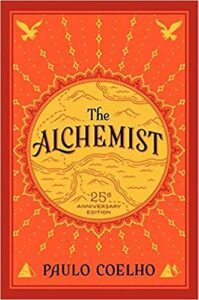 The Alchemist by Paulo Coelho
The Alchemist by Paulo CoelhoFormat: Audiobook; Length: 4 hours
I listened to this book in an afternoon and found it so moving with the sweeping nature of the story and the thoughtful reflection it offered. I still don’t feel like I absorbed everything that Coelho layers into The Alchemist so I plan to re-read this moving journey at some point.
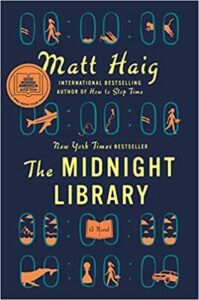 The Midnight Library by Matt Haig
The Midnight Library by Matt HaigFormat: Audiobook; Length: 9 hours
I found this book to be an unexpected and pleasant surprise, having seen it pop up a few places when it came available through my local library I snagged it. Haig, most well known for his non-fiction books Reasons to Stay Aliveand Notes on a Nervous Planet instead turns to a fictional world in The Midnight Library to explore what it means to take the road not taken and what it means to make a life you love despite the challenges you may face. Bonus, Haig is a delight to follow on social media (a rarity) and works to advocate for mental health.
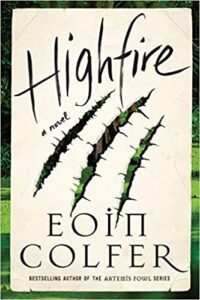 Highfire by Eoin Colfer
Highfire by Eoin ColferFormat: Hardcopy; Length: 377 pages
An ancient dragon living out his older years in the swamp lands of Louisiana and a kid who accidentally witnesses a murder make for an unlikely duo and a strange book. But somehow Hirefire makes it work and delivers the perfect blend of that kids on a heist genre I love and modern lore. The villains are straight up evil, the good guys are quirky and the plot has steady pacing and plenty of action. An unexpected delight in my winter reading this year.
 Miss Benson’s Beetle by Rachel Joyce
Miss Benson’s Beetle by Rachel JoyceFormat: Audiobook; Length: 12 hours
This quirky, funny story features something unique–a protagonist who is an older, slightly out of shape single woman for whom none of those facts are a problem to be solved or a hindrance to her adventure. Instead Miss Benson’s Beetle was a delightful, funny and adventurous read about two women who are trying to reinvent themselves and create a sense of excitement all their own.
 Fifty Words for Rain by Asha Lemmie
Fifty Words for Rain by Asha LemmieFormat: Hardcopy; Length: 464 pages
I wanted to love this Own Voice historical fiction about a biracial girl in post-WWII Japan but the longer time passes, the more troubled I am with how much trauma the author put her protagonist through. A single one or maybe two would have been enough to drive the plot but instead her main character faces trauma after trauma leading to a payoff that seemed…imbalanced? Fifty Words for Rain is definitely a book I want to talk about with other readers, but I am unsure if I want to recommend it.
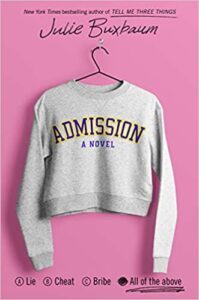 Admission by Julie Buxbaum
Admission by Julie BuxbaumFormat: Audiobook; Length: 9 hours
I normally don’t do novels based on a true story but when I saw Admission at the library I snagged. Did I picture Aunt Becky the whole time? Yep, sure did. But did this surprise me with a sense of nuance I didn’t expect from a story about rich people behaving badly? Also, yes.
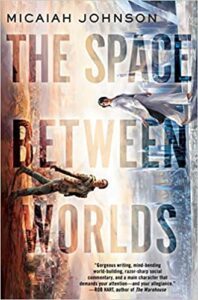 The Space Between Worlds by Micaiah Johnson
The Space Between Worlds by Micaiah JohnsonFormat: Hardcopy; Length: 336 pages
A gem of a sci-fi story about multiverse travel, the life we choose and the lives we don’t. Think Blake Crouch but relational, nuanced and with a much more diverse cast of characters. The Space Between Worlds will be a sci-fi book I recommend to readers that don’t read sci-fi for a long time.
 The Last Story of Mina Lee by Nancy Jooyoun Kim
The Last Story of Mina Lee by Nancy Jooyoun KimFormat: Audiobook; Length: 11 hours
I found The Last Story of Mina Lee one of the more moving stories of the winter. A story of the chasm between mother and daughter, migrant and first generation child, grief and hope, I cant fully relate but Kim managed to do that magical thing books can do–the more specific she became in the Korean immigrant experience, the more universal the themes became to me as a reader.
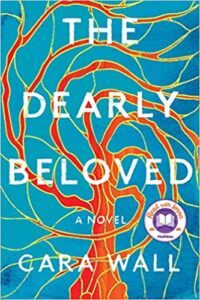 The Dearly Beloved by Cara Wall
The Dearly Beloved by Cara WallFormat: Hardcopy; Length: 342 pages
Easily my favorite book of all time, The Dearly Beloved by Cara Wall felt like the right book to revisit at the first of the year. Being immersed in the story of Nan and James, Charles and Lily as they negotiate their early years of ministry was just what my spirit needed. Tender without being saccharine, fierce and moving, I love this book and the story it tells about ministry and marriage.
 This Time Next Year by Sophie Cousens
This Time Next Year by Sophie CousensFormat: Audiobook; Length: 8 hours
Romance is a genre I have come around to in the past year in small doses. I enjoy that it has the potential to be a light hearted entry point into more serious themes. This Time Next Year balanced issues of family and mental health well and made it onto my list of reads that are lighthearted but still have substance.
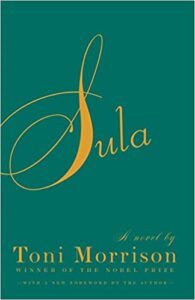 Sula by Toni Morrison
Sula by Toni MorrisonFormat: Hardcopy; Length: 174 pages
I’m not sure what I can say about Sula that hasn’t already been said about this classic. I marvel at the way that every author after Morrison draws on what she does so powerfully in her books. Every time I read something of hers I understand more deeply why I love the storytelling of Jesmyn Ward and the community building of James McBride and so many authors that are shaped by her work. For me, there is none other like Morrison because her influence and impact has shaped so many books I adore.
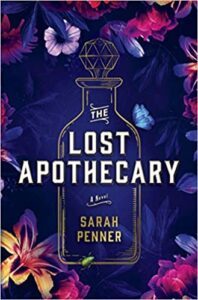 The Lost Apothecary by Sarah Penner
The Lost Apothecary by Sarah PennerFormat: Audio ARC; Length: 9 hours
Historical fiction with dual timelines are so common, but what makes The Lost Apothecary unique is the exploration of women’s autonomy and power and let’s be honest, the ethical use of poison to address the abuses of men in a world that give women very little power. I found one timeline written strong than the other, which is common in these kinds of books but still found it an enjoyable read. Thanks to NetGalley for the gifted audio ARC.
 The Boys Club by Erica Katz
The Boys Club by Erica KatzFormat: Hardcopy; Length:
This workplace drama centers around the first year of Alex’s time in a big law firm in NYC. I appreciated that Katz didn’t gloss over the perils of this world and didn’t tie everything up in a neat bow at the end. There was excellent plot tension that the author was able to maintain throughout the plot—making me want to keep turning pages/listening. If you like reads that are thriller-esque read about workplace drama with #MeToo themes, then The Boys Club would be a good book to pick up.
Non-Fiction
 Garlic and Sapphires: The Secret Life of a Critic in Disguise by Ruth Reichl
Garlic and Sapphires: The Secret Life of a Critic in Disguise by Ruth ReichlFormat: Hardcopy; Length: 334 pages
The unexpected delight of this book besides its throwback to the food scene in the 1990’s in New York was the many personas and aliases that Reichl creates to evade fine dining establishments and to test whether restaurants are capable of delivering consistent service to all their patrons, not just the critic for The New York Times. I loved the various personalities Reichl tries on in Garlic and Sapphires and what each one reveals about food and about herself. Just like in Save Me the Plums, Reichl is a queen at layering stories to build toward a larger, but not overdone point about how food and the restaurant experience serves as a mirror to who we are and who we want to be.
 12 Tiny Things: Simple Ways to Live a More Intentional Life by Ellie Roscher and Heidi Barr
12 Tiny Things: Simple Ways to Live a More Intentional Life by Ellie Roscher and Heidi BarrFormat: Hardcopy; Length:
12 TIny Things is a small, yet impactful book that works as a helpful guide to examining the small changes that can make a big impact in your life. I personally found several of the practices easy to integrate into my own life while still being impactful. The most fun, however, was my interview on the blog with co-author Ellie Roscher.
 A Rhythm of Prayer: A Collection of Meditations for Renewal ed Sarah Bessey
A Rhythm of Prayer: A Collection of Meditations for Renewal ed Sarah BesseyFormat: eARC; Length: 263 pages
There are a lot of books on prayer—some offer written prayers for the reader to say or adapt to their own circumstances, others attempt to describe the mystery and nuance of prayer and yet others function as a how-to guide. Rarely though do you find a book that is both invitational and informative, instructive and imaginative but Sarah Bessey manages to create a prayer collection in A Rhythm of Prayer that does all these things without being too much. You can read my full review HERE.
 Barking to the Choir: The Power of Radical Kinship by Gregory Boyle
Barking to the Choir: The Power of Radical Kinship by Gregory BoyleFormat: Hardcopy; Length: 208 pages
Barking to the Choir has sat on my shelf for far too long, so I was delighted when it was assigned reading for a course I took over the winter. Boyle strings together stories from his time as the head of Homeboy Industries, the largest gang rehabilitation community in the country. While Boyle’s stories often move from one to the other without little transition, they feel parabolic in the way they inform and instruct readers on the world as it is and the world as it could be.
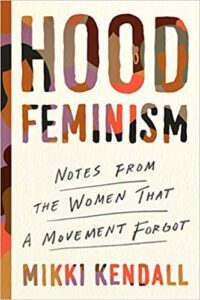 Hood Feminism: Notes from the Women that a Movement Forgot by Mikki Kendall
Hood Feminism: Notes from the Women that a Movement Forgot by Mikki KendallFormat: Hardcopy/Audiobook; Length: 267 pages/7 hours
Having committed to a life of anti white supremacy work for some time, I was delighted by Mikki Kendall’s Hood Feminism for the way it elevated the conversation on the aims of feminism to create a more comprehensive set of aims that considers the challenges that all women face, not just white women in pursuit of the boardroom. Both broad reaching in terms of scope and highly specific in its commentary and connection, a highly accessible book for readers that want to delve deeper into intersectional work.
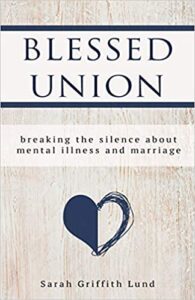 Blessed Union: Breaking the Silence Around Mental Illness and Marriage by Sarah Griffith Lund
Blessed Union: Breaking the Silence Around Mental Illness and Marriage by Sarah Griffith LundFormat: eARC Length: 96 pages
A short, but impactful read on mental health and marriage that combines personal narrative, mental health research and practical advice. I appreciated how Blessed Union disrupts the “pray it away” mentality of the church, while also taking faith seriously as a tool for a strong marriage and a support for mental health. I had the honor to interview the author Sarah Griffith Lund for my monthly author interview series.
Poetry
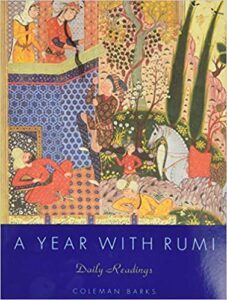 A Year with Rumi: Daily Readings by Rumi
A Year with Rumi: Daily Readings by RumiFormat: Hardcopy; Length: 432 pages
One of two volumes I read slowly over the course of 2020, I appreciated A Year with Rumi for its brevity as it could be digested in small snippets. The timeless wisdom of Rumi is always a good guide for the year, even if it’s a year we weren’t expecting and didn’t want.
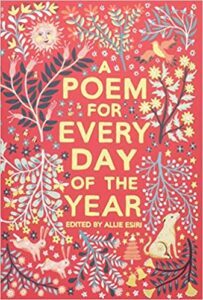 A Poem for Every Day of the Year by Allie Asiri
A Poem for Every Day of the Year by Allie AsiriFormat: Hardcopy; Length: 576 pages
My other volume I worked through slowly in 2020, this one I found to be much more hit or miss, which is more likely a reflection on the read than the editing or poems. A broad range of styles and topics make up A Poem for Every Day, however the collection itself felt very Eurocentric in its sections, so don’t let this be the only volume you read in a year.
Check out what I read last winter or you can see what I read (and liked) this fall. If you want to stay up to date on what I am reading from week to week you can follow along on Instagram or subscribe to my twice a month newsletter.
February 24, 2021
Interview with Sarah Griffith Lund and Blessed Union
As we settle into the end of winter blues and approach the start of our second year living with a pandemic, this month’s author interview feels incredibly timely. Many of my friends are talking about mental health, but not many of them feel comfortable talking about the impact of their pandemic mental health on their most intimate relationships or how the mental health of their closest relationships is impacting them.
In addition, I found author Sarah Griffith Lund’s book Blessed Union to be incredibly important resource for February, which is National Heart Health Awareness Month. One in every five children is born with a Congenital Heart Defect which means one in five parents is left to navigate the challenges and traumas of medical care and often surgery for their child. As a heart parent, we don’t often talk about the toll that stress takes on our mental health or the impact on our marriages.
I am honored to have the chance to talk with Sarah Griffith Lund about her newest release Blessed Union: Breaking the Silence Around Mental Illness and Marriage. A follow up book to her 2004 release Blessed are the Crazy: Breaking the Silence about Mental Illness, Family and Church, Blessed Union takes a deeper look at how to navigate and support our most intimate relationships at some of life’s most trying times.
Sarah’s twenty years of pastoral ministry has helped shape her passion for Mental Health Ministry. She currently serves as the first female senior minister at First Congregational United Church of Christ in Indianapolis and on National Staff for the United Church of Christ as the Minister for Disabilities and Mental Health Justice. What her bio won’t tell you is that Sarah is deeply gifted at holding tenderly the mental health journey of everyone she encounters in her work with thoughtfulness and care.

Cara: Mental Health and Marriage isn’t often a topic discussed openly, especially not in Christian circles. Tell me a little bit about why you chose to tackle a topic that often feels taboo.
Sarah: What life has taught me is that telling the true story about my life brings healing. This is what I practice doing in my therapy sessions: telling the truth. With my therapist I say out loud what I am afraid to admit to myself. Self-stigma keeps a lot of us from acknowledging the truth about how we experience mental health challenges. I know my therapist will not judge me and that together we can begin to create healing narratives about my life. Post-traumatic stress disorder (PTSD) is my body’s way of responding to the traumas in my life, and therapy is my way of healing from that trauma (along with lots of self-care practices like yoga, plant based diet, 8-10 hours of sleep).
I write about mental health as part of my healing journey. In the writing, I discover not only healing, but also blessings. The blessings come in the ways my writings create communities of compassionate conversation. I took on the topic of mental health and marriage because I was tired of feeling isolated because of the stigma and taboo, especially in Christian circles. From my research, I know that at least a quarter of all marriages are impacted by mental health challenges, so I know that I am not alone in these experiences. My hope is that my book Blessed Union will help us all know that we are not alone, and to encourage all of us to create communities of support and healing.
Cara: That balance between healing and blessing, community and connection is so beautiful. Our experience as heart parents who have been through so much medical trauma with our child is that sharing our story in community has been so healing.
One of the things I really loved about Blessed Union is the way you incorporated the voices of multiple couples, it feels accessible no matter what your story is around mental health and marriage. What made you decided to include other stories?
Sarah: I tell the stories of multiple couples and how mental illness impacts them to highlight the truth that every person with a brain can get sick. It doesn’t matter your age, culture, gender, education level, income, or marital status, because mental health challenges, like the common cold, can and do happen to most of us. There’s a wide spectrum of mental health with conditions ranging from mild depression and anxiety (the most commonly reported forms of mental illness) to addiction, to eating disorder, to bipolar disorder, to schizophrenia. Over the past several years, I’ve collected hundreds of stories from other couples and I began to realize in a profound way that it wasn’t just me and my marriage. I love that Blessed Union shows us in the multiple stories about different marriages that we are not alone. The power in hearing multiple stories and our collective story telling helps shatter the shame and stigma of mental illness.
Cara: We share a similar stream of the Christian tradition, but I am always surprised when I encounter Christians that are struggling with mental health who think they shouldn’t get help—that Christians should pray their mental illness away or “hand it over to God.” For the Christian couple who might have been raised with this perspective, how would you explain a more expansive understanding of mental health? And what tools would you recommend they add to their tool box to support mental health in their marriage?
Sarah: The most powerful teaching of the Christian faith is that God loves each one of us. For Christians struggling with their mental health, I encourage us to be guided by God’s love. I call this God’s Big Blessed Love.
Love desires for us to flourish and to thrive, to praise God with our whole being. For many of us with mental health challenges, flourishing, thriving and praising God can be hard to do when we are experiencing symptoms of mental health conditions that cause us to feel despair, hopeless, low self-esteem, irritated, worthless, and helpless. The key is to remember that we are created in God’s image and that we are not defined by how we feel in the moment or by our illness or diagnosis our worst symptoms. Yet, stigma keeps us from loving ourselves. As Christians, we can help to end stigma by learning how to love ourselves, especially when we are experiencing mental health challenges.
Because God wishes for our health and wholeness, and because Jesus teaches us to love our neighbors as ourselves, we love ourselves by taking care of our mental health. God gives us the tools we need through medical advances in brain science and through the talents of therapists, psychiatrists, and phycologists. An excellent tool for marriages is a free online mental health screening by Mental Health America that will provide guidance as to what resources may best help you along your healing journey. (https://screening.mhanational.org/screening-tools/)
Cara: The way your work insists that mental health isn’t solitary work but also the healing work of community is refreshing. There have been so many research-based articles about the impacts of the pandemic and its social isolation on mental health, so Blessed Union feels so timely. If couples are feeling the strain, where should they start?
Sarah: As the global pandemic enters its second year, we are all feeling it. Our mental health is going to be what gets us through this rough time. For couples feeling the strain, the stress, the endlessness of the pandemic, a good place to start is to get a group of friends (one or two other couples or more) and read Blessed Union together. I designed the book to be read in community, with discussion questions and prayers throughout the book. There’s even a journal tucked into the last dozen pages with prompts to help open up honest and real exploration about mental health.
The best place to start is wherever you are right now, getting honest with yourself first. How are you reallydoing? It’s okay to not be okay. Sometimes, especially for faithful Christians, the “Savior” complex covers up what’s really going on inside of us because we’ve gotten so used to saving everyone and everything around us. There’s extra pressure to rescue and save if we are also parenting. But we are living in a time where we can’t get through this alone. We are going to need the help of others. Being physically isolated from others for the past year is taking its toll. It is vitally important for us to find healthy ways to get emotional and mental health support from people who genuinely care. Telehealth therapy and couples counseling is a good option for safe and meaningful connection and mental healthcare.
Cara: One of the reasons I was so excited to read Blessed Union and to talk to you is because mental health has been a huge part of my journey as a partner and parent. A few years ago my daughter had open heart surgery. It was supposed to be a routine procedure with minimal risk, but there were complications and she ended up having two more unplanned surgeries in a matter of days. That’s traumatic as a parent, let alone trying to navigate that your partner might also be going through the same experience but processing it in very different ways. You also have the responsibility of helping this other small human process their own mental and emotional experience, it can feel like a lot.
So many heart parents have the strain of hospital stays, medical bills, doctors visits and the unknown looming in their relationship. How do you encourage couples to care for their mental health in the midst of a family medical crisis, especially when it involves the caregiving of a child?
Sarah: It’s important to remember that your feelings belong to you and are valid. A single event can impact two people in very different ways, as you describe in your marriage. It’s important to honor the diversity of ways of processing trauma and try not to judge what response is “correct” or “good.” Sometimes we judge ourselves or shame ourselves, thinking our emotional response is not the “correct” one. Or we can suppress our feelings or we can feel numb, all of these are valid ways to feel. I highly recommend having both an individual therapist and a couple’s therapist. In your individual therapy, you can share and process thoughts and feelings about the marriage and your partner in a safe space. These conversations can help you know what to work on in couple’s counseling. This is an investment of time and money, and it is way less expensive than divorce.
Whenever there is a child involved, remember that children have a story they are telling themselves about whatever it is that is going on. Most of the time the stories our children tell themselves are going to be centered around themselves as the primary cause of whatever problem is at hand. Be ready to explain to a child in very simple terms the following: (1) we are getting the best help available to us, (2) the problem is bad and we are working on making things better, (3) this is not your fault, (4) this is part of what it means to be human, (5) you can ask any questions you want, and (6) we love you no matter what.
Cara: What are some small tips you can give parents going through difficult experience, like a child’s open heart surgery or long term hospital stay, to support their mental health and marriage?
Acknowledge that this experience will not last forever. There was a *before* and there will be an *after* and you will survive.It’s understandable to get tunnel vision and be fully focused on the difficult experience at hand. This type of hyper awareness is mentally exhausting. Take mini-breaks to think about something else and do something else, even if it seems silly or unimportant. Crossword puzzles, jigsaw puzzles, going for walks, playing with the dog, watching Netflix, are all ways to give your mind something else to think about.Our bodies carry around our emotional stress and trauma. We forget to breathe, we forget to stretch, we can forget to eat or how to sleep. Being extra intentional about taking slow, deep breaths, eating healthy food, drinking lots of water, taking showers, and relaxing so we can sleep are all important for mental wellness.Stress can be released through safe, gentle, and caring touch. Try to hold or hug your partner for at least 20 seconds. (I count backwards from 20 in my head when I hug my partner.) This extended amount of affection tells our brains that we are safe and helps to release stress, replacing the stress with positive feelings.
Cara: What is one thing you wish people knew about mental health and marriage?
Sarah: Even when things are bad, they can get better. I think about Psalm 23 and the valley of the shadow of death because sometimes it can feel like we are in the valley in our marriages. Scripture promises that God is with us to guide us and comfort us and to lead us out of the valley. I find great encouragement and hope in the promise that God’s Big Blessed Love is with us always. I believe with all my heart that healing and recovery are possible.
Cara: There are so many great resources for mental health, what are some of the ones you recommend frequently?
Mental Health America (www.mhanational.org)
National Alliance for Mental Illness (www.nami.org)
Pathways to Promise (www.pathways2promise.org)
United Church of Christ Mental Network (www.mhn-ucc.org)
Cara: Where can people find you if they want to connect or learn more about your ministry?
Sarah: You can buy my book anywhere books are sold! If you’d like a personally signed copy of my book, check out my online bookstore. You can also find me on Facebook and Twitter and I have a Newsletter where I talk about mental health so that’s a great place to get quick, digestible resources delivered right to your inbox.
My most favorite conversation about mental health ever was this special event, “Real Talk About Real Marriage” with my friends and mental health experts. Check out–it makes a great date night and conversation starter.
February 15, 2021
Diamonds and Dust: An Ash Wednesday Meditation
“And, lo, the star which they saw in the east,
went before them, till it came and
stood over where the young child was.” -Matthew 2:9, NKJ
The first book I picked up in 2021 was Father Gregory Boyle’s second book Barking to the Choir: The Power of Radical Kinship. A collection of stories and theological reflections on his time at Homeboy Industries, a ministry Boyle founded as a Jesuit priest that has grown to be the largest gang intervention program in the world is equal parts despairing, moving and hopeful. Which made it quite the fitting read to pick up as we celebrated epiphany and watched the tragic violence that took place at the US capitol the first week of the new year. Each page is filled with funny and thoughtful stories about the lives of the formerly incarcerated or gang initiated. Boyle has a way of taking a phrase or a moment and turning it just a quarter turn so that we might see that what he was holding all along in the lives of men and women was indeed a gem. Or as one of the homies shared upon his graduation “you are a diamond covered in dust, here you can brush the dust off.”
I am not going to lie, 2020 and the start of 2021 feels like everything is covered in dust. A thick, grimey layer of anger, frustration, disgust and grief over systemic racism, pandemic mismanagement and the consequences of growing economic divides. It seems so counter to the story of Epiphany that Christians celebrated the same day as the riot at the Capitol. The story of wisemen traveling by the light of a star that would lead them to the Christ child, God’s bright light of hope in the darkness. But then I remember, that I am only remembering the easy part of the story–the arrival, the discovery, the triumph of the wisemen’s journey. As much a part of this story as starlight is the dark shadow Herod cast upon the manger. And it wasn’t until I read Boyle this year that I realized that the story starts with an invitation to look or as Boyle points out:
“But lo–which is to say, look–right before your eyes,
the holy is happening, even if you are hesitant to believe it.”
Even if you are hesitant to believe it, the holy is happening. Yes, even in a pandemic the holy is happening. When the news can’t seem to get much worse, lo, the holy is happening. When our country’s history of systemic racism threatens to swallow us whole, lo, even if you are hesitant to believe it, the holy is happening. Even in grief, maybe even especially in grief, the holy is happening. Boyle reminded me of the string that ties together Epiphany and Ash Wednesday, ties together hope in the face of violence, thriving in the midst of oppression, joy in the midst of grief. On Ash Wednesday we are reminded our faith isn’t just about diamonds and starlight, it’s about dust and darkness too. It’s about being hesitant and fearful and uncertain and yet still being willing to look up and look around at what holiness might be in our midst. Ash Wednesday reminds us of the wisdom of the homie who said “you are a diamond covered in dust, here you can brush the dust off.” Here in the story of Christian faith you can be a dusty ass diamond. Here you can be seen as beloved by a God that loves you, mortal and created and here you can be dusty and deserving.
Like what you’ve read? Want more? Sign up for my twice a month newsletter (because we’re not spammy) and get original content you can’t find here on the blog. Reflections on faith and living, book recommendations and other good, nerdy fun. Sign up HERE.
February 8, 2021
5 Lighthearted Books with Substance
A few weeks ago I was on a Zoom happy hour with my girlfriends when one of them declared “I wish I liked your book recommendations but you like serious and heavy stuff and right now I really need something light!” Honestly, I love when I get book recommendations wrong because it gives me the chance to ask “What books do you enjoy?” She rattled off what she had read and loved recently as I listened. What was so funny is that we are reading many of the same books!
The bulk of the audiobooks I read are lighthearted because they are easier to follow while multitasking. I love lighthearted books to break my reading slump or to read after something heavier. However, I probably don’t rave about them as often as I should.
I also recognize that what each person considers light hearted is different. For me, I need the the characters in my lighthearted reads to have some conflict–a personal struggle of some sort–to make the story interesting. I also don’t mind if my lighthearted reads touch on a difficult issue or subject as long as the ending ties up well and the subject is handled with care. Here are the five lighthearted books with substance I would recommend.
 Red, White and Royal Blue by Casey McQuisson
Red, White and Royal Blue by Casey McQuissonIf you like rom coms that also work to imagine a more diverse and inclusive American political landscape, this book will leave you crying in the best possible way. Red, White and Royal Blue is more than just a story about Alex and Henry, sworn enemies from across the pond, it’s a book about hope and imagining a better world.
 This Time Next Year by Sophie Cousens
This Time Next Year by Sophie CousensA new release this year, I enjoyed this romance that also weaved in class issues and mental health. It’s part of the recent move to publish books with more inclusive stories, This Time Next Year was a pleasant surprise. I also found I really loved all the subplots in this book, which is rare that all the subplots are engaging and contribute to the story.
 The Authenticity Project by Claire Pooley
The Authenticity Project by Claire PooleyWhen a book like The Authenticity Project is called “warm and charming” I generally think “sweet and fluffy” and steer clear. But with consistently high reviews I decided to give this book a try and I am glad that I did.
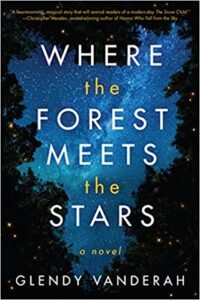 Where the Forest Meets the Stars by Glendy Vanderah
Where the Forest Meets the Stars by Glendy VanderahA book about a girl that suddenly shows up claiming to be an alien is definitely a stretch, but trust me if you just go with it, you will find an enduring and sweet story about chosen family. Where the Forest Meets the Stars definitely surprised me with its unique, heartwarming and thoughtful story.
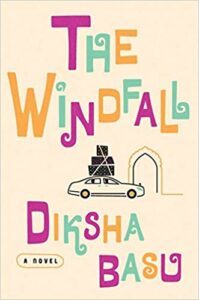 The Windfall by Diksha Basu
The Windfall by Diksha BasuI read this the first summer after leaving my full time congregational job, I was burnt out and my brain was mushy with grief. The Windfall was the perfect book because it was equal parts light-hearted and funny but with some insightful commentary on class striation and striving.
I would love to know what is on your “lighthearted with substance” book list! Drop your favorite in the comments.
Like what you’ve read? Want more? Sign up for my twice a month newsletter (because we’re not spammy) and get original content you can’t find here on the blog. Reflections on faith and living, book recommendations and other good, nerdy fun. Sign up HERE.
February 6, 2021
What to Bring to the Hospital When Your Child Is Scheduled for (Heart) Surgery
With a child who has had multiple open heart surgeries, we have become veterans at overnight hospital stays. After living in the Pediatric Cardiac ICU once for twelve days and another stay where I found myself in the ER with a 30% charged cell phone and a wallet, bound for another weeklong stay, we learned quickly what we needed to make a difficult time a little more manageable.
Of course, the small things that might bring you comfort under a challenging circumstance might be different, but I’ve gathered up a list of our must haves–a mix of practical and comforting. But I would love to hear from other parents what is on your list.

Socks or slippers
No one wants to wear their shoes while sleeping but you also don’t want to go walking around a medical facility with bare feet. So a good pair (or two) of socks or a pair of slippers can be a lifesaver for the up and down routines of the night. Bonus if the socks have grippers on the bottom–no one wants to slip and fall while caring for their little one.
A notebook
You think that when the doctor comes by to talk you will remember everything but that’s not how your stressed out and traumatized brain works. The doctor might come by while your spouse ran home or to get something to eat, so taking notes will also help you communicate important details to them as well as help you remember what you heard. It can also be a place to jot down the questions that come to you at 3am when your mind is busy but the unit is quiet so you can remember them the next day.
A cozy blanket
The hospital will provide you with a blanket to use while sleeping in your child’s room but it’s likely to be nubby, scratchy or smell like industrial laundry. In other words–not like home. When all the sounds and smells and stress keep you from relaxing and grabbing a few hours of rest, bringing a cozy blanket can help signal to your brain and your body that it’s time to relax and catch a few Z’s.
Healthy snacks
Somehow when you remember you need to eat, the hospital cafeteria is closed or all you can find is junk food. And while a bag of Chex Mix might get the job done it won’t give you the nutrients you need to stay sharp and process new information. I always try to pack some sort of healthy snack–durable fruit like apples and oranges, protein bars and trail mix.
Headphones and Chargers
Our daughter’s third surgery was a surprise. I found myself in the ER with my wallet, keys, my cell phone charged to 30% and a partner on a flight bound over international waters. Not the best time to find yourself without a cell phone charger. When we have the chance to plan we pack a pouch full of all the cell phone, Kindle, laptop and iPad chargers we might need so we can stay connected and entertained. Headphones can be helpful to listen to a show while your heart hero naps or if your child is older for them to use to tune out hospital life for a bit and play a game or watch a movie.
A nice towel
Like a blanket, the hospital will provide it but it will be nubby and small. If you are planning a stay longer than a day or so (and you have access to a shower on site) your own towel can be a comfort and convenience.
Lip Balm and Moisturizer
Hospitals are dry places on purpose to prevent the growth of unwanted things, but that means your lips and hands will likely get dry. A tube of lip balm for you and for your child and some moisturized can make you more comfortable during an uncomfortable time.
A Friend or Two on Speed Dial
Some days in the hospital float by in a haze and some are filled with information and decisions to be made. At the end of the day (or the middle of it) a good friend that will listen to you worry or celebrate milestones or let you talk things out or understand when you need a solid distraction is incredibly valuable. A friend that won’t repeat harmful platitudes or offer “bright sides” in your suffering is priceless. Know your people and know who you can call for support, ask them ahead of time (if you have that luxury) if they can be on speed dial.
A Book
There are times where you are highly involved in your child’s care but there are large lulls in the day when you child might be napping and hospital staff leave you to rest. If you can’t doze a good book can be a quiet time to pass the time and a welcome distraction. Personally I prefer something light and entertaining–think witches or rom coms or YA. Any from this list of light reads would be a good fit.

A comfort item (blanket or stuffie)
We were advised by our Child Life specialist to bring something that would give our child comfort. She was in preschool at the time so we selected a favorite blanket. She was grateful for the chance to snuggle under it in the hospital at night. We also brought her favorite stuffed animal which worked as a comfort and also a tool to help her process her experience. Even if your child is too young to appreciate such gestures–you will appreciate the gesture of nurture towards your child in moments when you feel helpless.
Cozy socks
Little toes can get cold and so we like to bring socks for her. Bonus for socks with grippers on the bottom for safety when your kiddo can finally get up and walk around (if they are walking age). Double bonus if they are brightly colored, your child’s favorite color, silly, funny or unexpected. Sometimes the smallest things could brighten my child’s day.
Hair care items
No one told me about the giant knot that would form in the back of my daughter’s head after anaesthesia or a night of tossing and turning in discomfort. Now when we have the luxury of planning for our surgery, I take the time to neatly braid her hair out of the way. But sometimes that’s not the case, so having a hairbrush, a tiny spray bottle of water, rubber bands and clips on hand has been helpful. I am not sure that moms of boys face the exact same challenge but if your child’s hair is long, course or curly it’s good to bring something to manage the unruly bedhead they get from laying around in a hospital bed with limited mobility.
Favorite Movie, Card Game or Book
Our daughter had her first surgery at the peak of Frozen fever (if you know, you know). The hospital still worked on DVD players and they only had one disc of the beloved movie so we brought our copy. While technology has changed (and our daughter’s taste in entertainment), the need for physically calm activities that sooth, relax or educate has not changed. Infants love music, bigger kids enjoy movies and of course big kids can be distracted with a card game or two. Be sure to grab a few tunes, shows or games that will help ease your child’s mind during their stay.
This list is by no means exhaustive so I would love to hear, if you are a parent who has had to navigate surgery and overnight hospital stays, what have been your must have items?
Like what you’ve read? Want more? Sign up for my twice a month newsletter (because we’re not spammy) and get original content you can’t find here on the blog. Reflections on faith and living, book recommendations and other good, nerdy fun. Sign up HERE.
January 30, 2021
Steady Sundays: Sabbath Practices to Shape a Steady Presence and Life
This year my word is steady. I aim to be steady in my partnering and parenting, steady in my ministry and writing. Steady in showing up for the people, moments and movements that matter. The word steady didn’t come to me from nowhere–it showed up as an extension of what worked well in a year where nothing turned out how we expected. In a year that felt ever-shifting and unpredictable, it was showing up steadily that created growth and progress.
So I thought, one Sunday a month I would share practices that steady my days, weeks and life. These are not overhaul practices, they are small things that over time have made a difference in how I show up for myself and others well. If you are curious about the power of tiny things to make a big impact, you can start with this interview with author Ellie Roscher where we talk about small habits, resisting grind culture and making small changes with small human afoot. I have even created a small worksheet to help you do your own reflection linked bellow.
I want to share small, steady practices that have anchored me, kept me moving and created connections over long periods of time. Just as Brene Brown says “you can’t hotwire connection” you also can’t hotwire the results of a steady practice in your life. There is no big overhaul that can replace the impact of steady habits and spiritual practices done each day.
As I thought about what those practices were in my life, I realized that many (but not all of them) stem from the Sabbath practices we’ve cultivated as a family over the years. Sunday seems to be a steady sun in which my week orbits and doing a few small things on Sundays can often set the rest of my week smoothly into the unknown of a new week or leave me careening, looking for a reset.
Starting at dinner on Saturday nights, we begin our Sabbath time. We work to make sure that all the groceries are purchased and chores are done. We make sure emails have been checked and projects have come to a natural stopping point. All of this preparation is to carve out one day from dinner to dinner to cease from work and engage in holy rest and rituals.
As Walter Brueggemann claims in his book Sabbath as Resistance, “Sabbath is not simply the pause that refreshes. It is the pause that transforms. Whereas Israelites are always tempted to acquisitiveness, Sabbath is an invitation to receptivity, an acknowledgment that what is needed is given and need not be seized.”
Carving this time out has allowed us to shape practices that have created meaning, prioritized faith formation and made the week run smoother. Rather than a time to organize ourselves towards a busy week, Sabbath is essentially a day that re-orders our priorities for the week ahead. I am really looking forward to sharing the small practices each month and I am looking forward hear what practices have created a sense of steadiness in your life as well. If you are looking for a tool to help you think about you steady practice you can checkout the handout I made Creating Steady Practices.
Like what you’ve read? Want more? Sign up for my twice a month newsletter (because we’re not spammy) and get original content you can’t find here on the blog. Reflections on faith and living, book recommendations and other good, nerdy fun. Sign up HERE.
January 27, 2021
Start Close In by David Whyte
My conversation with author Ellie Roscher about her most recent book 12 Tiny Things: Simple Ways to Live a More Intensional Life was so much fun, I hope you check it out. The whole time I was reading the book I kept thinking of the poem Start Close In by the poet and philosopher David Whyte. The opening line begins “start in close/don’t take the second step/or the third,/start with the first/thing/close in.” A line that begs simplicity as an act of remaining grounded in one’s truest self, a self created in love by God. I am sharing the full poem for the start of the year, for the commitment to simplicity and for listening to the simplicity of your calling.
Start close in,
don’t take the second step
or the third,
start with the first
thing
close in,
the step
you don’t want to take.
Start with
the ground
you know,
the pale ground
beneath your feet,
your own
way to begin
the conversation.
Start with your own
question,
give up on other
people’s questions,
don’t let them
smother something
simple.
To hear
another’s voice,
follow
your own voice,
wait until
that voice
becomes an
intimate
private ear
that can
really listen
to another.
Start right now
take a small step
you can call your own
don’t follow
someone else’s
heroics, be humble
and focused,
start close in,
don’t mistake
that other
for your own.
Start close in,
don’t take
the second step
or the third,
start with the first
thing
close in,
the step
you don’t want to take.
Start Close In can be found in David Whyte’s collection River Flow: New and Selected Poems. If you enjoyed this poem I made a full color printable PDF version you can print HERE.
Like what you’ve read? Want more? Sign up for my twice a month newsletter (because we’re not spammy) and get original content you can’t find here on the blog. Reflections on faith and living, book recommendations and other good, nerdy fun. Sign up HERE.
January 21, 2021
Book Review: A Rhythm of Prayer
There are many prayer books available to clergy, worship leaders and those who engage in spiritual direction. Some provide prayers to be adapted to one’s own use and some talk about the understanding and practice of prayer. What makes each of them work is the specific way that they engage prayer without going too broad. So I was surprised and delighted to discover that A Rhythm of Prayer: A Collection of Meditations for Renewal aims so broadly and yet touches so deeply on the heart of prayer I could imagine this book for almost anyone in my circle–pastors looking for sermon fodder, parishioners that want something to invigorate their personal devotional time, and friends that possess a spiritual longing yet don’t affiliate with a faith community.
What I appreciate the most is the diversity of the contributors as well as the diversity of texts. Each section brings something new and unexpected. A breath prayer adapted from scripture passages written by the editor, a prayer formed around the step of making chicken noodle soup from scratch that centers the work of justice by Osheta Moore, a prayer for those weary and tired written by Laura Jean Truman that reads as a traditional prayer or liturgy but feels like a Psalm, a liturgy for disability and prayer for chronic illness, a poem by speaker Kaitlin Curtice that reads like a breath of fresh air, an essay on the physicality of prayer by Kelley Kikondeha, each give breadth and life to the collection. And sprinkled throughout are quotes and scriptures that speak to the meaning and practice of a practice that at its heart seeks to know God. There is a steady candor to the work of prayer in this books that is both nurturing and challenging, a difficult balance to strike.
I would give this book to my Midwestern mother and to my coastal activist friends and know they would each get something pleasurable and thoughtful from the collection.
January 20, 2021
Interview with Ellie Roscher and 12 Tiny Things
I am deeply honored to welcome teacher and writer Ellie Roscher as my first guest for the new author interview series. Not only is Ellie the author of three books including How Coffee Saved My Life: And Other Stories of Stumbling Towards Grace and Play Like a Girl: How a Soccer School in Kenya’s Slums Started a Revolution and her newest release 12 Tiny Things: Simple Ways to Live a More Intentional Life. She is also the host of the podcast Unlikely Conversations, a yoga instructor and writing instructor at The Loft Literary Center and the Minnesota Writing Project. I met Ellie at a conference last year, right before Covid changed the terrain of our lives and made in person conferences a wistful memory. What her bio doesn’t share is what an incredibly gracious and warm presence Ellie exudes.
I wanted to interview Ellie about her recent release 12 Tiny Things because I personally found the book to resonate with where I am as a mother and pastor after nearly a year of pandemic living. My own reevaluation of goals and recommitment to the idea that tiny things can make the deepest impact on my own life meant that I took so much wisdom from the pages of 12 Tiny Things. I hope you enjoy our conversation this week.

Cara Gilger: You and your co-author Heidi Barr have worked on this project for several years, your research was shaped pre-pandemic, but I found it so relevant to our family’s Covid reality. Tell me what inspired 12 Tiny Things when you started the project?
Ellie Roscher: Several years ago, a group of like-minded women, including Heidi and me, got together to wonder, “What is enough?” We asked the question not from a place of scarcity, but a place of abundance. What is just the right amount? We were all trying to live a bit more simply and intentionally. In a society that tells you more work, more money, and more stuff is always better, it felt a tiny bit radical to be challenging that premise and living life on purpose.
12 Tiny Things was born out of the Enough project. Heidi and I were seeing similar trends in our work worlds. Her wellness clients and the young adults in my ministry were feeling paralyzed with overwhelm. They were looking for support in identifying what the first step is to get unstuck and cultivating a sense of peace and joy in their lives. Heidi and I started a Facebook group three years ago and called it 12 Tiny Things. Each month we would choose a theme and post a tiny practice around that theme. The community grew quickly. We were onto something.
Heidi and I both love practicing tiny things and encouraging others to do the same. We are living the belief that little things are big things. We can find rootedness in life on the go. During those three years, I would slip into facilitator mode and skimp on my tiny things practice. The nice thing about tiny practices is you can easily pick them back up again. I would begin again and instantly feel more rooted, living life from my core.
Cara: How has Covid and the changes people are facing in their work and home lives challenged or affirmed the work you’ve started in 12 Tiny Things?
Ellie: As you said, Heidi and I wrote 12 Tiny Things before the pandemic. Three years into my tiny things practice, it was more relevant than ever. Yet, there was a whisper inside me when I picked up the proof to review before publication that said, “Will this hold up in COVID? Will it still be relevant? Or is it too small?” I was immediately struck by how the relevance had deepened with our changed reality.
I deeply believe that now more than ever, tending to our physical and mental health contributes to the common good. That is a new conviction that grew out of our COVID existence. Staying healthy matters to more than just me. 12 Tiny Things supports my health and well-being. The COVID grind is real. Getting through each day is challenging in new ways. Practicing my tiny things every day invites me into the present moment, marks time and keeps me renewed. We are not waiting for life to resume. This is life, and tiny things help me stay awake to this wonderous life.
Cara: I absolutely love the idea that our physical and mental health contributes to the common good. I have found that with us all at home all the time in Covid, it’s the small things that matter most to our thriving even if thinking about what to do seems overwhelming. Where do you suggest starting?
Ellie: One tiny thing I practice every day is to go outside and look all the way up to the sky. It takes one minute of my day, but every time I do it something in my shifts. My body relaxes, I take a full breath, and I see the vastness of the beautiful universe. It reminds me that I am small, and the world is big. It reminds me that my house is not the whole world. Another tiny thing is taking three conscious breaths. It takes a few moments, and every time it works for me as a reset. My body relaxes, I arrive in the present moment, I remember I am alive, and I begin again.
The boundaries between work and home life have dissolved. I love that only one of the twelve themes is work. We are called not just to work, but to our whole lives. It is a book that celebrates holistic vocation at a time when we are realizing that our occupation is to love each other and show up in all sorts of ways.
Cara: In the beginning of 12 Tiny Things you talk about the role of “loving kindness” as a primary component of creating change. This seems so simple but it’s really counterintuitive to the messages we get about “leveling up” and “hustle” and “grind” culture—how do you encourage readers to make the shift from an aggressive model for change to one that is rooted in gentleness?
Ellie: We are human beings, not human doings. Our hustle and grind culture leads to burn-out and self-deprecation. It treats us as consumers first and not spiritual, embodied beings who were created good and beautiful. 12 Tiny Things is a gentle invitation to subvert the lies and live from a sense of enough. Our first chapter is on SPACE. What is one area in your life where you would like more space: your email, closet, mind, garage, or calendar? The invitation in that chapter is an invitation to ENOUGH. What is the myth driving us toward more instead of enough, toward clinging instead of letting go?
For me, I overfill my calendar because I believe that I am more when I do more. That is a lie, and when I can name it as a lie I immediately start living out of a heightened sense of enough. The tiny thing, then, is to say no to one thing. By exploring the invitation to enough with gentle self-love, I find the courage to say no to one calendar invite that does not bring me joy. That tiny thing is actually quite enormous. Now I have more space. I can either dwell in the potential and power of the space itself, or I can intentionally fill that space with something on purpose. Life is no longer happening to me. More is not always more. If we can gently explore what is underneath the current, what is driving the striving for more, real personal transformation can happen one tiny step at a time. Living from our root system and the truths about our beauty, our enough-ness and our perfect imperfection that dwell under the surface, we can find a sustainable pace and cultivate the life we want.
Cara: I love that each chapter ends with a Body Practice and reflection questions to guide readers through this work. Is there a Body Practice that has been particularly meaningful to you in the new year?
One tiny body practice is to pull your chin toward your throat just a bit, and then reach the crown of your head toward the sky. This small shift changes my entire disposition. I feel the alignment in my spine and the space created by elongating my spine. Those two sensations trigger to my being to live out of alignment, to move from my core literally and figuratively. It reminds me that it is ok to take up space. It is ok to stand tall. When my chin juts out, it is a body manifestation of this striving for more, extending myself out until I am spread thin, looking outside of my body for happiness, and spending too much time out in the future. When I pull my chin back in alignment, I come back to home base. It is an invitation from my physical body to my being to remain in the present, find happiness in what I do have here and now, dwell in a sense of stillness, tap into the depth of my being, and recognize all I need is right here inside me. I can live with a calm sense enough. It is a mindful one inch shift in my body that washes over me and changes how I move through my day.
Cara: As someone that writes about faith formation, I deeply appreciated that your section on spirituality was expansive, including practices and perspectives outside of the Christian tradition. Why was it important for you to integrate such a broad lens to talk about spirituality in this book?
Ellie: The young people I work with in a Christian setting are skeptical of organized religion. They do not want to be associated with the homophobia, misogyny, xenophobia and white supremacy alive in the vocal minority of certain strains of US Christians. Yet these young people long for a meaningful spiritual life and a spiritual practice. They want to live their life on purpose, and they want they faith to flow from Sunday morning into all the nooks and crannies of their lives. They formed their identities with smart phones in their pockets, knowing global hurt and oppression at an intense level and wondering what their role in in the healing. I wrote 12 Tiny Things with them in mind. I did not want them to get hung up on Christian lingo that is loaded for them. Our 12 Tiny Things community is diverse and rich. Christians and church communities can opt into the larger community while using the shared vocabulary from the book in their church settings.
I am a practical theologian, and I love engaging with 12 Tiny Things as a Christian. I want other Christians and church communities to engage with me. I wrote a 12-week church study guide that brings in the themes of 12 Tiny Things in conversation with 12 Bible stories that I love. This resource is a simple, free downloadable 12 week study for churches. It is malleable and works well on ZOOM and in person. Churches can expand or contract it, use it for small groups, Wednesday nights, women’s groups and teens and young adults. On our Resource Page of our website, we also have meditations, a small group guide, a 30-day calendar and a daily Lenten calendar for folks to use. My hope is that church communities can bring the strength of their relationships and life-giving semantics to the 12 Tiny Things structure and meanwhile, folks who are looking to deepen their spiritual life outside the structure of institutional religion can joyfully do so.
Cara: Many of my readers identify as women and mothers with young children, their days are both joyful and exhausting. If you were to say “hey start here, right here, with this tiny thing” where would you recommend they start?
Ellie: I love this question. I wrote 12 Tiny Things when my youngest was an infant after two miscarriages, two hard full-term pregnancies, one hard labor and two abdominal surgeries, and an extended stint in the PICU when my youngest was a newborn. I was tired in mind, body and spirit. I was surviving. We find ourselves in seasons of surviving and seasons of thriving. In it all, we can claim rootedness. Heidi and I spent a lot of time created practices that were so tiny, offensively tiny, that no one could claim they were too busy. It is a place to start. Not all the tiny things will work for you, but there is an appendix of tiny things to choose from, and just a couple can build a sense of embodied simplicity and intentionality regardless of how exhausting our days are.
Allow me to give a couple of options of where to start. Choose just one, and try it for a month.
Spend the first five minutes of your day away from screens. As you wake up to the new day, get in touch with your body and your immediate surroundings. Identify yourself as a being in the analog world first. If you grab for your phone right away, try getting an alarm clock and charge your phone in a different room.Nod to your machines. As you start the coffee maker, start your car or boot up your computer, give it a nod of recognition. We have a relationship to our stuff, and there are so many machines in our lives that we take for granted yet make our days easier so we can choose delight.Decide what your body really wants to drink first thing in the morning. When we are tired, we can lean on routine and get stuck in ruts. Maybe you have had coffee first for years when your body actually wants a glass of water before coffee. By taking a moment to check in with not what you think you want but what you really want, it sets a tone for your day where your desire matters.
Looking all the way up at the sky and taking three conscious breaths, mentioned previously, are great places to start, too. Our social media community on Facebook is also a great place to start. For some folks on Instagram, it is just a gentle pause in their feeds. It is a gentle reminder to breath and put down the scrolling if it is not serving you. For others, it is a rich space to share ideas and support each other on the journey. Parenting can be isolating, and this groups is a light touch to help you feel not quite so alone.
Cara: If readers want to connect with this work, where can they find you?
Ellie: You can find me on Facebook, Twitter and Instagram and you can find 12 Tiny Things, our community for connecting people to this work on the 12 Tiny Things website, as well as Facebook and Instagram. As I mentioned before, we offer these spaces to create gentle reminders in your feed and build community.



